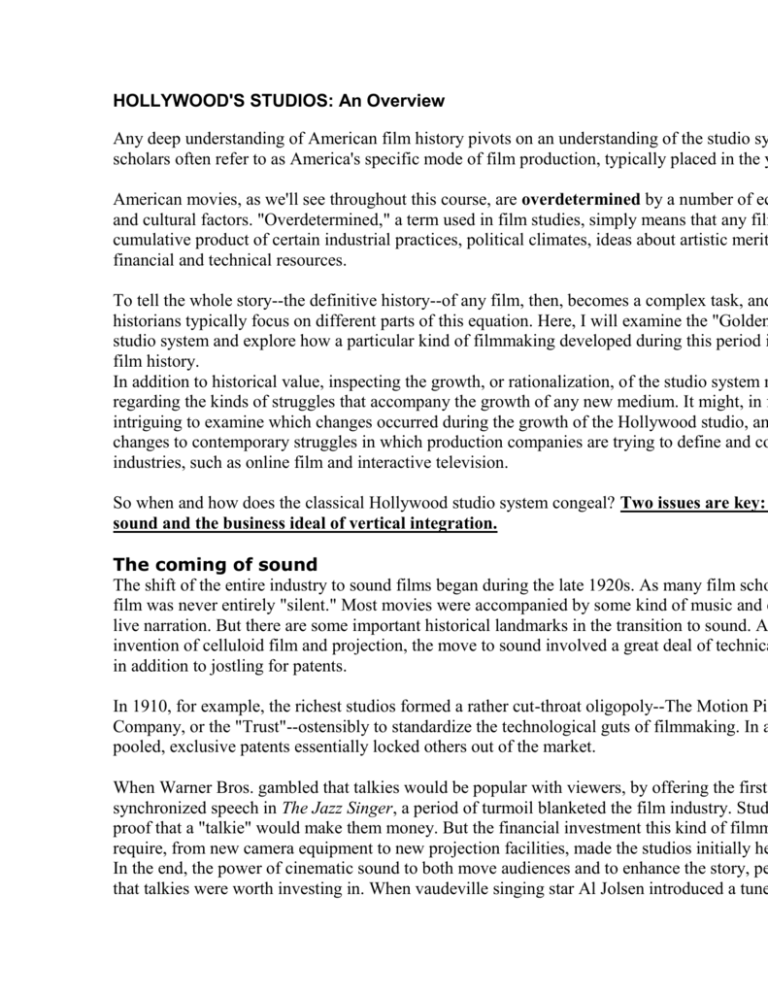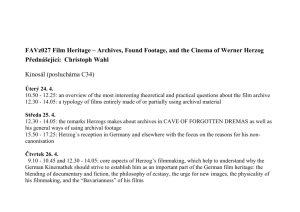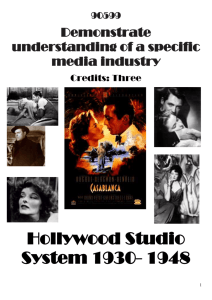HOLLYWOOD`S STUDIOS: An Overview
advertisement

HOLLYWOOD'S STUDIOS: An Overview Any deep understanding of American film history pivots on an understanding of the studio sy scholars often refer to as America's specific mode of film production, typically placed in the y American movies, as we'll see throughout this course, are overdetermined by a number of ec and cultural factors. "Overdetermined," a term used in film studies, simply means that any film cumulative product of certain industrial practices, political climates, ideas about artistic merit financial and technical resources. To tell the whole story--the definitive history--of any film, then, becomes a complex task, and historians typically focus on different parts of this equation. Here, I will examine the "Golden studio system and explore how a particular kind of filmmaking developed during this period i film history. In addition to historical value, inspecting the growth, or rationalization, of the studio system m regarding the kinds of struggles that accompany the growth of any new medium. It might, in f intriguing to examine which changes occurred during the growth of the Hollywood studio, an changes to contemporary struggles in which production companies are trying to define and co industries, such as online film and interactive television. So when and how does the classical Hollywood studio system congeal? Two issues are key: sound and the business ideal of vertical integration. The coming of sound The shift of the entire industry to sound films began during the late 1920s. As many film scho film was never entirely "silent." Most movies were accompanied by some kind of music and e live narration. But there are some important historical landmarks in the transition to sound. A invention of celluloid film and projection, the move to sound involved a great deal of technica in addition to jostling for patents. In 1910, for example, the richest studios formed a rather cut-throat oligopoly--The Motion Pic Company, or the "Trust"--ostensibly to standardize the technological guts of filmmaking. In a pooled, exclusive patents essentially locked others out of the market. When Warner Bros. gambled that talkies would be popular with viewers, by offering the first synchronized speech in The Jazz Singer, a period of turmoil blanketed the film industry. Stud proof that a "talkie" would make them money. But the financial investment this kind of filmm require, from new camera equipment to new projection facilities, made the studios initially he In the end, the power of cinematic sound to both move audiences and to enhance the story, pe that talkies were worth investing in. When vaudeville singing star Al Jolsen introduced a tune minute. Wait a minute. You ain't heard nothing yet," audiences shrieked in delight. From that there didn't seem to be any going back to the days of silent film. During that same year, Fox worked to establish itself in the transition to sound films. Warner Vitaphone sound-on-disc system met direct competition by Fox's Movietone sound-on-film sy specialized in newsreels, and debuted their sound system with footage of Charles Lindbergh's Paris in 1927. When audiences heard Lindbergh's words and the plane's take off, they reporte cheered in the packed Roxy Theater in New York for over 10 minutes. Overall, the use of sound in film was well-received by all audiences, but there were still many factors to consider. Over the next few years, problems with amplification of sound were worked out and most the converted for sound. By 1929, Hollywood put out more than 300 sound films and the full inte sound into film was complete by 1930. It would take a bit longer for films to regain their styli and dexterity, however, since the camera now had to be encased in a big, clumsy, unmoveable box. Suddenly all the ground that had been gained with the moving camera and complex-editing st lost. Even actors struggled, having to direct their speech to awkwardly-hid microphones in hu telephones or even their costumes. The film Singin' In The Rain (1952) comically yet accurate these early-sound film difficulties. Vertical integration of the film industry Vertical integration is another key component of the Hollywood studio system. The major stu they could maximize their profits by controlling each stage of a film's life: production (makin distribution (getting the film out to people), and exhibition (owning first-run theaters in major Five studios, "The Big Five," worked to achieve vertical integration through the late 194 vast real estate on which to construct elaborate sets. In addition, these studios set the exa films' release dates and patterns, and operated the best movie palaces in the nation. Warner Bros., Paramount, 20th Century Fox, Loew's (MGM) and RKO (Radio-Keith-O formed this exclusive club. "The Little Three" studios--Universal, Columbia and United Artists--also made pictures, but e of the crucial elements of vertical integration. Together these eight companies operated as a m oligopoly, essentially controlling the entire market. They also controlled the terms under which you could see their films. Prestige or A-level film stars and lavish production values, and then could only be seen initially in studio-owned, first When the studios released these films to theaters they didn't own, they forced those owners to in combination with a number of, often mediocre, B-pictures (no stars, bargain-basement gen shorts, a practice called "block booking." Moreover, the studios often made the exhibitors buy blind, not allowing them to see what they were getting before they got it.








